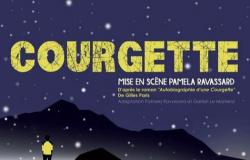Reading time: 4 minutes
“The Typewriter and other sources of hassle”, by Nicolas Philibert
An investigative technique practiced by geographers and police investigators, triangulation magnificently becomes a cinematic procedure. Deploying a triple approach to the psychiatric world, to those who populate it, who live it, Nicolas Philibert provides access to it in a unique way, in increased relief, one could say.
The Typewriter and other sources of hassle is the third look at the same issues, after On the Adamant And Averroes & Rosa Parks. Third point of view which makes a film in its own right, with a tremendous richness of emotion and understanding. And also a luminous contribution to the whole, where the echoes from one film to another respond and stimulate each other.
After the warm attention on board this unique place of care that is the barge welcoming patients from the Paris-Centre Psychiatric Center into a day hospital in the first film, then the attentive listening, with the camera as much as with the microphone, in the institutional framework of the Esquirol hospital, here the places where some of those who the said Center live live are ajar.
Tiny, almost bare studio or shambles haunted by the traces of a thousand dreams, affections and commitments of a saturated life, these places already tell, to those who know how to film them, something about their occupant.
This is where members of the “orchestra”, this group of caregivers, arrive, always in pairs, who, in addition to their medical-psychological tasks, are responsible for helping to resolve the patients’ material problems.
It seems anecdotal and, on the contrary, it is powerfully obvious as soon as we stop at it. Something is broken. A typewriter, a CD player, a printer, or the possibility of organizing your daily space. Something is broken, too, in these people who need psychiatric care.
From the opacity of the mental disorder to the materiality of the rivet to be changed or the shelves to be arranged, the cinema implemented by a filmmaker knows not how to make the link, but to bring out the thousand effects of meaning and emotions, well within -beyond singular cases, precisely by staying as close as possible to them.
The sick, the handy caregivers, the cinema people crowd into each of these places, and everyone goes there. To the best of his ability, with his condition, his knowledge, the particular nature of his attention and his energy. And it’s magnificent.
Walid and Jérôme are busy with Muriel, whose life, already not easy, became grim when she was no longer able to listen to music. | Screenshot Les Films du Losange via YouTube
At this point it is even strangely magnificent, as the multiplicity of situations, responses, practices, “vocabularies” (verbal, gestural, visual, etc.) amplify and respond to each other.
And now this vast tree structure, part of the simplest, most trivial, in turn resonates with the other two films. Between the three of them, they connect heterogeneous practices (serving coffee, accompanying an anxiety attack, repairing a device) which cannot be generalized, but say a lot about the multiple vertigos which haunt humans.
Without grand speeches, we can see many of the multiple responses that modes of organization and individuals invent to the infinite spectrum of trouble. Thus, Nicolas Philibert’s trilogy deploys an immense landscape of sensitive attention, where we see, where we feel that it was not a triptych on psychiatric care, but a living thing that concerns us all.
“The Island”, by Damien Manivel
A priori, nothing to do with the above. On a beach, a group of teenagers spend one last night with Rosa, who must leave them to continue her studies in Canada. Games of affection and seduction, small settling of scores, exultation of bodies and energies, attacks of melancholy in the descending evening.
And then the same – and not the same. Same bodies and same faces, same situation played out, but in what seems like a classroom, a rehearsal studio, sometimes with interventions from the director. Repetition, in fact, of what had begun to be played out “in real settings”, as they say. But what is an actual setting?
The image is raw from filming, close to the bodies, the quivers, the slightest inflections – the same for the voices. We will return to the seaside, and again where the fictional choreography is developed. What island is the title talking about?
Maybe this is where the beach is, we won’t know. Perhaps the state in which they find themselves, isolated from adults, from vacations that are ending, from the world of work or studies that will follow. Or perhaps it is the film itself, which constructs in this coming and going between two states a separate continuity, completely documentary and completely fiction.
Since his beginnings and throughout his films, Young Poet has
Magdala Passing by The park
And Isadora’s ChildrenDamien Manivel continues to invent new forms, where his quality as a dancer and choreographer participates in multiple ways in the exploration of rhythms, distances, forms of presence and presence of forms.

Rosa, who is leaving tomorrow –Rosa Berder, who plays the role of Rosa. | Screenshot La Traverse via YouTube
It is interesting but secondary to know that The Island
is not the film that the filmmaker had planned to make, but the one that he composed from sequences recorded with the young actors to prepare for a shoot that never took place.
In fact, on the screen, in the vivid fragility of the situations, in the circulation between the emotions played and the emotions experienced by the performers, in the most vibrant of a face that blushes, of a look that turns away, of a choked voice, an adventure blossoms.
Adventure of the film, in the double sense of that which it actually tells, and that which it itself becomes, without separation between the two. We move and kiss each other, challenge each other and make fun of each other, listen to each other and ignore each other.
We experience the most of what can be invented alive, in the double urgency of the last evening together before lives are turned upside down, and of a film to be made into existence all the same, although the powers of money have decided otherwise.
So yes, “somewhere”, the strictly documentary experience of Nicolas Philibert with his three films around what we call madness and care, and the experimental invention of Manivel converge.
Or? On a movie screen, definitely. But, more decisively, in the immense and joyful confidence in cinema itself, and the bets, each as extravagant as the other, as completely won as the other, of all that can meet through the means implemented.
Beyond the usual format (three films rather than just one) or below, in the crucible of preparing for a production that will not come to pass, forces of intelligence and sensitivity flourish in ways of ‘all the more vivid as they are unusual.









